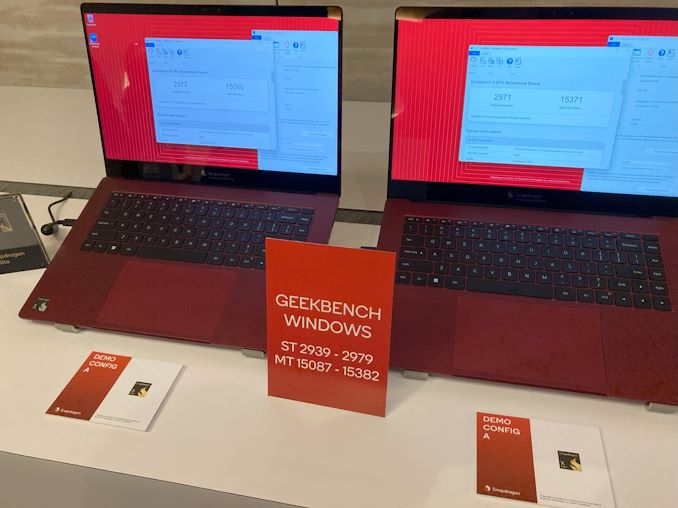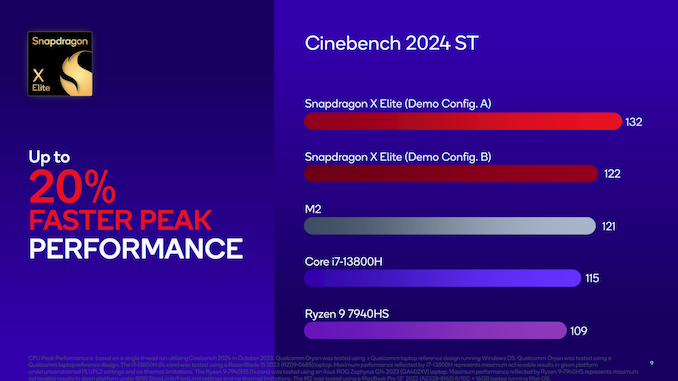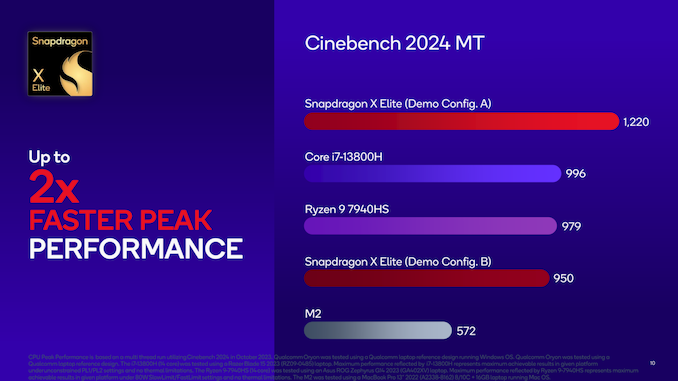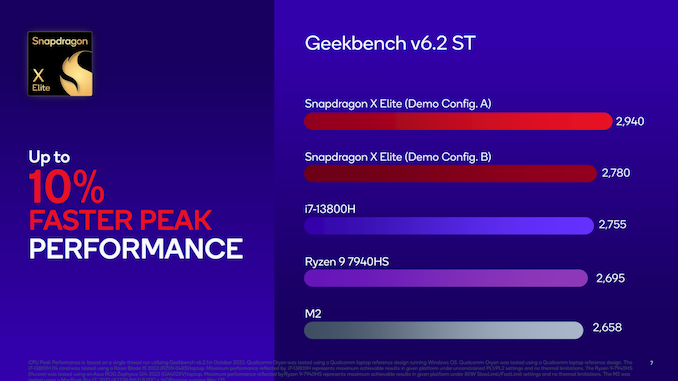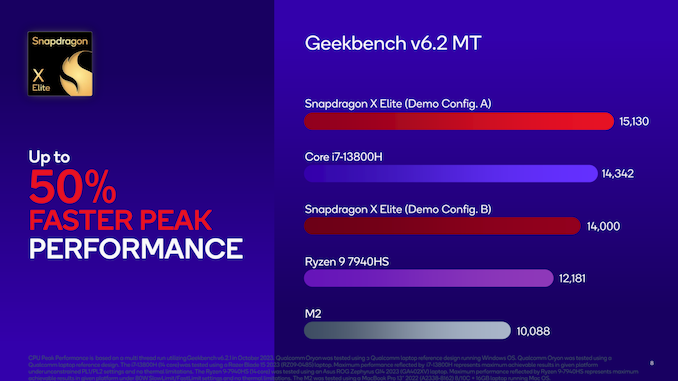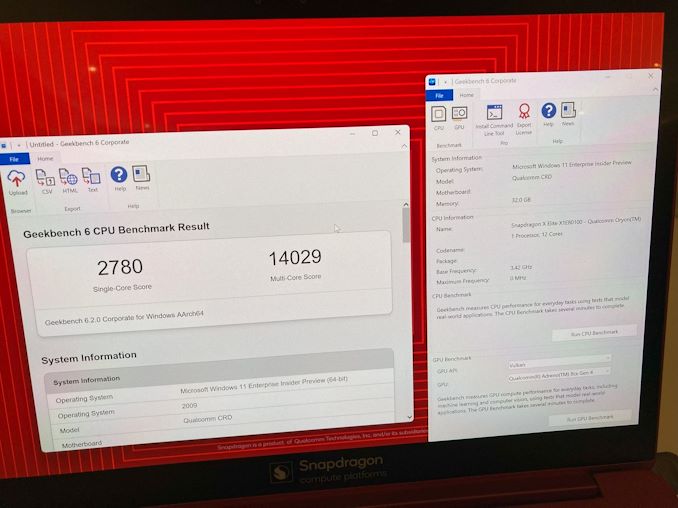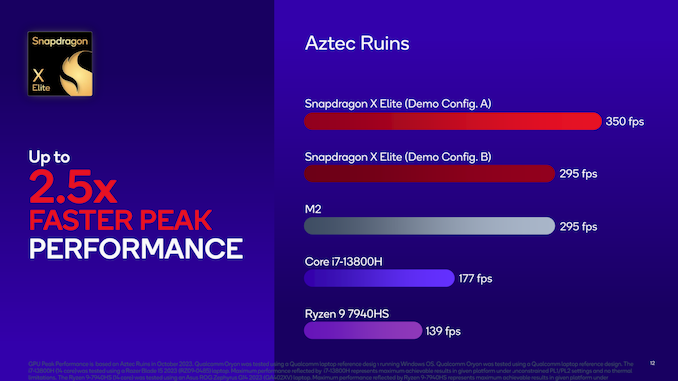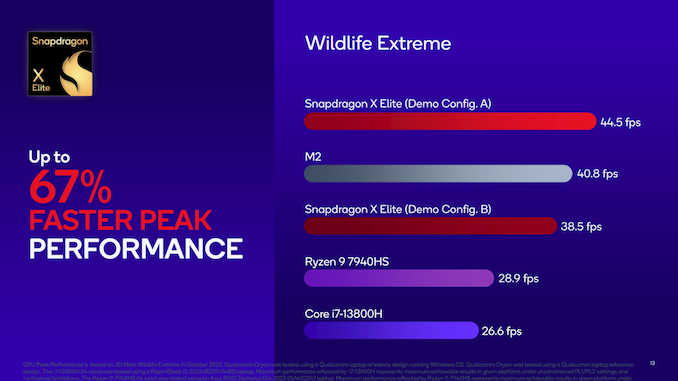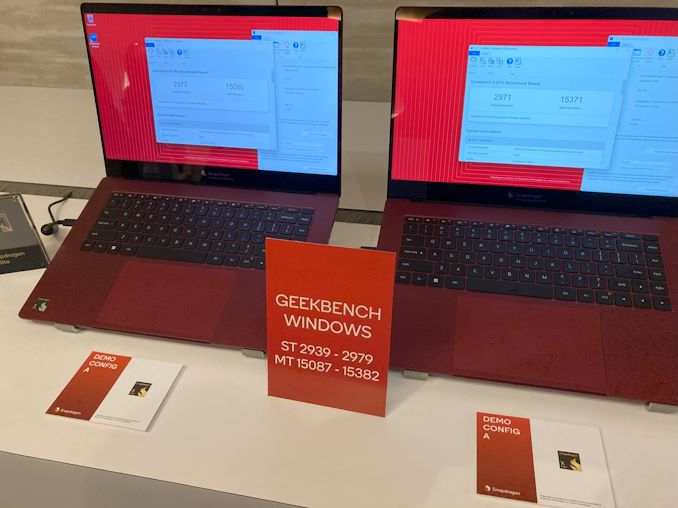
Last week we saw the announcement of Qualcomm’s first post-Nuvia laptop SoC design, the Snapdragon X Elite. A new brand name being anchored by a new, custom Qualcomm CPU core, the Snapdragon X Elite will be Qualcomm’s most aggressive entry into the laptop SoC market to date, with Qualcomm dedicating far more in the way of engineering resources – and marketing resources – into developing their latest generation Arm SoC for Windows laptops. Backed by Qualcomm’s custom Arm CPU core, Oryon, the company is aiming to make the Snapdragon X Elite a watershed moment for the Snapdragon brand, both carving out a piece of the lucrative Windows laptop market while also setting the stage for a generation of even more powerful smartphone SoCs in 2024.
As outlined in the company’s keynote and related announcements at last week’s Snapdragon Summit, Qualcomm is incredibly proud of (and gung-ho on) the Snapdragon X Elite, and they are eager to show off what it can do. With benchmark scores that, in some cases, are beating some of the best chips from Intel, AMD, and Arm, Qualcomm believes they have a hot hand with the Snapdragon X Elite, and they want to show it off as soon as possible. Even despite the fact that actual retail devices won’t be available until mid-2024 – at least another 6 months from now.
As part of that promotional push, alongside the public disclosures at last week’s event, Qualcomm also held an embargoed event for press and analysts to further demonstrate the Snapdragon X Elite and its performance. In a closed-door benchmarking session, the company set out a series of Snapdragon X Elite reference design laptops pre-loaded with popular benchmark software, most of which the company had also used in its performance claims from last week’s keynote sessions. The purpose of the session was to demonstrate in front of the gathered crowd that Qualcomm’s reported benchmark scores were no exaggeration or anomaly, and that the company had devices up and running right now that could hit those chart-topping scores. As the saying goes, “seeing is believing,” and Qualcomm’s benchmarking session was all about making sure the Snapdragon X Elite was being seen in action.
With devices not arriving until next year, today’s disclosure is very much a preview. And a hands-off one at that; while the press was allowed to observe the benchmarks in action, we weren’t allowed to touch the laptops (least we try to run CPU-Z or Crysis on them), as Qualcomm is holding back on disclosing some of the technical details of Oryon and the Elite SoC altogether. So while we can report on what we saw, it’s important to note that these are Qualcomm’s benchmark numbers, and not our own. Though with Qualcomm picking highly standardized benchmarks, they’re trying to keep things as comparable and above-board as possible.
Competitive Context: Timing Is Everything
Part of Qualcomm showing off so many benchmark results so soon is, simply put, a matter of pride. It’s not every day your company gets to show off a new SoC anchored by a custom CPU core developed by a team of engineers, that, by and large, draws from the CPU architects behind Apple’s highly performant A/M series SoCs, never mind their collective experience from even earlier projects. The establishment of the Nuvia team almost 4 years ago made waves at the time thanks to the stacked talent and the potential to disrupt the current CPU core ecosystem, and while the Qualcomm acquisition changed that trajectory from servers to mobile devices, the potential for disruption is still there.
If nothing else, the introduction of a clean sheet high-performance CPU design makes Oryon the most interesting story in hardware tech right now, and the most interesting thing to happen in the CPU space since the introduction of Apple’s M1. And if the Snapdragon X Elite as a whole can deliver on those performance claims – CPU, GPU, and NPU – then that makes things all the more interesting. As a result, Qualcomm is very, very eager to demonstrate the hardware that going to be behind their next-generation laptop, handset, and automotive designs.
At the same time, however, revealing Snapdragon X Elite and publishing benchmark figures for it is all about timing. Qualcomm wants to control the narrative as much as possible – they want the Snapdragon X Elite to be seen now and compared to rival hardware now. Not next day, next week, or next month.
Ultimately, the 6+ month gap until retail devices launch means that the competition for Qualcomm’s upcoming SoC isn’t going to be today’s chips such as the Apple M2 series or Intel’s various flavors of Alder/Raptor Lake. Almost everyone is going to have time to roll out a new generation of chips between now and then. So while Qualcomm’s SoC may be ready right now, we’ve yet to see what they’ll be competing against in premium devices. That doesn’t make today’s benchmark disclosure any less enlightening, but it means that Qualcomm is aiming at a moving target – beating Apple, AMD, or Intel today is not a guarantee that it’ll still be the case in 6 months.
In any case, besides being able to pick their competition, an early preview also gives Qualcomm a chance to line up OEM partners for their new SoC. The 8cx chips, three generations in all, have been successively unpopular. Despite the fact that the software side of the Windows-on-Arm ecosystem finally came together in the last couple of years with Windows 11, the 8cx Gen 3 has been the least-adopted chip from an OEM standpoint; only a handful of devices, such as the Lenovo ThinkPad X13s and Microsoft’s not-a-Snapdragon Surface Pro 9, were released based on it. So Qualcomm would like to reverse that trajectory by lining up more OEMs and more designs for what is intended to be a much higher-profile chip launch for the company.
The Reference Laptops: Big & Smaller
Diving right into matters, for their benchmark demonstration, Qualcomm put together two reference design laptops. Dubbed “demo config A” and “demo config B”, the systems are essentially DTR-style and thin & light laptops, somewhat in the range of Apple’s 14-inch and 16-inch MacBook Pro designs. Qualcomm won’t be selling laptops based on these designs, but they are meant to show off what OEMs can do with the hardware, and how the hardware would perform in similar designs.
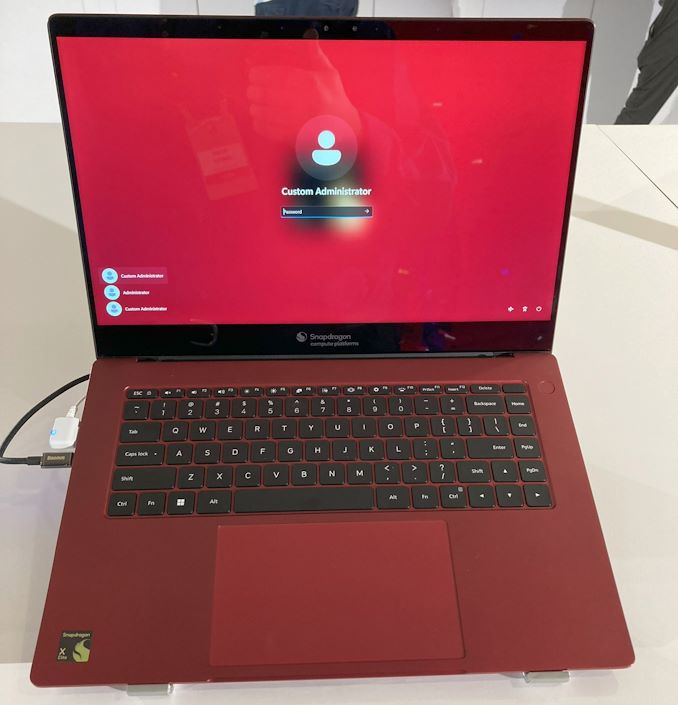
“Demo Config A”, a high-performance 16.5-inch DTR reference laptop design
Showcasing reference designs for performance purposes is very typical overall for Qualcomm. This is also how the company handles their smartphone testing – in most years we’ll get to benchmark a Snapdragon mobile SoC running in a Qualcomm Reference Device (QRD) as a preview before retail devices are available. Even though they’re not a vertically integrated company, they still need to develop devices to test their own hardware, and they like to use those to initially show off their designs.
| Qualcomm Snapdragon X Elite Reference Test Systems | ||
| AnandTech | High Perf System (Config A) |
Thin and Light (Config B) |
| 2 Core Max Turbo | 4.3GHz | 4.0GHz |
| All Core Max Turbo | 3.8GHz | 3.4GHz |
| RAM | LPDDR5X-8533 | LPDDR5X-8533 |
| Display | 16.5-inch LCD 3840×2160 |
14.5-inch OLED 2880×1800 |
| Thickness | 16.8mm | 15mm |
| Device TDP | 80W | 23W |
| Cooling | Active | Active |
| Battery | 87Wh | 58Wh |
Besides differing in physical size, the two laptop designs have different performance and TDP envelopes. The high performance (A) system gets an equally high performance Snapdragon X Elite chip, with a maximum clockspeed of 4.3GHz for 2 core turbo, and 3.8GHz for all-core turbo. The smaller thin and light system (B) is clocked lower, at 4.0GHz for 2 core turbo and 3.4GHz for all-core turbo. The laptops have lower TDPs as well; Qualcomm is disclosing what they call “device TDPs” for the laptops, which are 80W and 23W respectively. This puts the thin and light laptop on the edge of being able to be passively (fanless) cooled, but here Qualcomm is using active cooling on both laptops.
Notably, here, both laptops are paired with LPDDR5X memory running at 8533Mbps/pin. While other laptop vendors also support LPDDR5(X), none of them support these data rates with their current chips (most of which top out at LPDDR5X-6400). So the Snapdragon Elite X systems are getting a roughly 33% memory bandwidth bonus right off the bat – something that is especially helpful in GPU benchmarks.

“Demo Config B”, a portable, 14.5-inch reference laptop design
Otherwise there is little to say about the systems, especially as we did not get the chance to touch them. They’re essentially meant to give us a look at the Snapdragon X Elite’s performance in TDP-constrained and unconstrained scenarios, showcasing how performance still remains high even while scaling down in power.
The Numbers: Observed vs. Qualcomm Official Guidance
As well as providing the laptops, Qualcomm also provided official guidance numbers for the hardware, mirroring the results that were in their keynote slides from earlier days. The purpose of their official numbers was to disclose the official performance range for their hardware, with the demo units on hand to demonstrate that they’re actually attaining those numbers. In other words, the official guidance is the performance Qualcomm has been getting in the lab, while the press was there to observe that they were attaining those numbers with real-world hardware.
As an aside, I’m told that most of Qualcomm’s official data was put together by former AnandTech guru Andrei Frumusanu. Which helps to explain why Qualcomm’s official figures are based on averaging out three runs of the various benchmarks, with the results presented as ranges. It’s a level of statistical finesse that few (if any) manufacturers provide.
| Qualcomm Snapdragon X Elite Benchmark Scores | ||||
| AnandTech | High Perf – Observed | High Perf – QC Expected Range | Thin and Light – Observed | Thin and Light – QC Expected Range |
| Cinebench 2024 ST | 132 | 131-132 | 124 | 122-123 |
| Cinebench 2024 MT | 1227 | 1211-1233 | 997 | 925-973 |
| Geekbench 6.2 ST | 2971 | 2939-2979 | 2780 | 2722-2798 |
| Geekbench 6.2 MT | 15371 | 15087-15382 | 14029 | 13849-14007 |
| Linux: Geekbench 6.2 ST* | 3236 | N/A | N/A | N/A |
| Linux: Geekbench 6.2 MT* | 17387 | N/A | N/A | N/A |
| PCMark 10 Applications | 13498 | 12869-13112 | 12737 | 12433-13516 |
| GFXBench Aztec Ruins – Normal | 354 fps | 355-357 fps | 294 fps | 294-296 fps |
| 3DMark Wildlife Extreme | 45 fps | 44.65-44.78 fps | 39 fps | 39.0-39.2 fps |
| UL Procyon AI* | 1766 | 1750-1800 | 1813 | 1750-1800 |
For their demonstration, Qualcomm lined up Cinebench, Geekbench, UL’s PCMark 10 Applications, Procyon AI, and 3DMark Wildlife Extreme benchmarks, as well as Kishonti’s GFXBench 5.0 Aztec Ruins. At first blush, it’s an unusual mix of benchmarks for a laptop demonstration, as many of these benchmarks are better known for being used in smartphone and tablet reviews. So it is not especially a PC-centric set of benchmarks.
But with Qualcomm wanting to put their best foot forward – in part by ensuring everything run here was with native Arm binaries – it’s not surprising to see them sticking to a core set of benchmarks that are as equally optimized and tested for Arm as they are x86. According to Qualcomm, the benchmark decision was based on, in part, using benchmarks they frequently encountered in laptop reviews. In either case, it means that we’re looking at a slate of Arm-native benchmarks, without any x86 emulation at hand.
Overall, all of the results we observed from the reference laptops fell within Qualcomm’s official performance ranges – if not exceeding them slightly in the case of PCMark 10 Applications. While Qualcomm’s choice of benchmarks may or may not be cherry-picked to an extent, the numbers they’re reporting are accurate.
I’ve also put asterisks on a few benchmarks, though for different reasons. For the Procyon AI benchmark, the Qualcomm devices were running against Qualcomm’s own Snapdragon Neural Processing Engine (SNPE) runtime, which allowed them to access the NPU functions of the SoC. So this was not done using a vendor-neutral API, such as DirectML. Furthermore, in Qualcomm’s keynote slides, they were comparing data to AMD and Intel chips running CPU paths; so the end result is an NPU vs. CPU comparison, a very apples-to-oranges setup.
As for the Linux Geekbench results, because Qualcomm does not yet have fan control working under Linux, these systems were running with their fans on full blast. Whereas the Windows systems were running with more typical fan ramp curves, and thus didn’t enjoy the Linux laptops’ effectively unlimited thermal environment. Regardless, the primary purpose of the Linux demo was to showcase that Linux was working on the Snapdragon Elite X as well – that it’s not just for Windows – as Qualcomm has aims of getting the SoC into Linux laptops as well.
Putting the Numbers in Context: Snapdragon X Elite vs. The World
The validity of Qualcomm’s official numbers aside, they mean very little on their own. We need some kind of performance comparison to give them some context for just how well Snapdragon X Elite is performing.
Unfortunately, Qualcomm’s eclectic choice of benchmarks makes any kind of third-party performance comparison very difficult. AnandTech itself does not review much in the way of laptops, and even across our publisher’s entire footprint, our sister sites like Tom’s Hardware, Laptop Mag, Tom’s Guide, and TechRadar don’t use most of these benchmarks in laptop reviews. Never mind the fact that some, like Cinebench 2024, are barely two months old.
As a result, we don’t have sufficient (and consistent) data of our own to use in a performance comparison. So what we’re left with are Qualcomm’s own performance slides, which present data from select Intel, AMD, and Apple systems.
Specifically, Qualcomm has collected data from a 2023 Razer Blade 15 (Core i7-13800H) running at an unconstrained TDP, a 2023 Asus ROG Zephyrus G14 (Ryzen 9 7940HS) running at an 80W power limit, and a 2022 13-inch MacBook Pro (M2). Notably, this group does not include Intel’s top mobile chip, the Core i9-13900H, but it does cover AMD’s top chip. Meanwhile the M2-powered MBP13 is the least-constrained option for showing off the vanilla M2 chip, but it lacks the greater CPU and GPU core counts of the Pro/Max variants used in the 14-inch and 16-inch MacBook Pro models.
Notably absent are any other Qualcomm-powered notebooks. So we don’t have any Snapdragon 8cx Gen 3 data to use as a comparison.
Qualcomm was quick to show off their Cinebench 2024 results in their keynote address, and understandably so given how popular of a CPU benchmark it is. Pulling ahead in single-threaded performance is no small task, given the constraints of both extracting more IPC from a given workload, and the lack of headroom to improve clockspeeds as vendors once could.
Multi-threaded results are a bit more lopsided; most of the other chips in this chart only have 8 CPU cores. Even in the case of the 13800H, only 6 cores are performance cores (and the other 8 efficiency cores), which in a test of pure CPU throughput would put the Intel system on the back foot.
Geekbench 6.2 is a narrower cluster of results. Of course, Qualcomm has themselves winning in single-threaded performance twice-over (both SDX Elite systems), though as Geekbench is a composite score of multiple sub-benchmarks to begin with, it’s hard to say how the chips compare in any given task. Things open up with multi-threaded results, as is expected, though again, not by as much as Cinebench.
Switching over to GPU benchmarks, we have GFXBench Aztec Ruins. This is arguably the oddest choice of inclusion for a laptop benchmark suite, as, especially in “normal” mode, Aztec Ruins is designed for smartphone benchmarking. Never mind the fact that this benchmark is 5 years old.
Qualcomm’s results have them well in the lead here. But given how unconventional this benchmark is in the PC space, I have significant doubts over whether it’s been meaningfully optimized for within Intel and AMD’s driver sets. The M2 is likely the only meaningful comparison.
3DMark Wildlife Extreme, by contrast, is a more of a relevant GPU benchmark. But it’s still a cross-platform benchmark written with smartphones in mind – in this case using the more strenuous “extreme” setting. Typically, the graphics score of this benchmark is reported, rather than the frame rate. So it’s not a pure GPU benchmark.
In any case, Qualcomm has in recent years gone in heavy with their integrated GPU designs in the smartphone space – usually outpacing the most recent Apple mobile SoC – so it’s not too surprising to see evidence of that here as well. Anything on the level of the M2 should have little trouble outperforming current x86 iGPUs, though I am a bit surprised that Qualcomm isn’t pulling further ahead of the M2 as well.
Regardless, being that these are Windows PCs, I’m more eagerly awaiting benchmarks using Windows games. While Qualcomm will have to pay the x86 translation penalty, real games are going to be much more relevant towards real-world performance than a synthetic benchmark is.
Finally, for the sake of completeness, I’m also including Qualcomm’s last slide for the UL Procyon AI benchmark. As noted earlier, these results are highly misleading without additional context: only the Qualcomm chips are running on an accelerated (NPU) backend. The Intel and AMD chips are using the generic Windows ML CPU backend.
With that said, this situation is not Qualcomm’s fault – the Intel chip doesn’t have an equivalent NPU, and AMD’s isn’t sufficiently exposed to be used in this benchmark – so their results aren’t incorrect. But this is, at best, an aspirational benchmark, showing the benefits of having an NPU versus doing things on the CPU. Which, by the time the Snapdragon X Elite ships, all of the major vendors will be shipping hardware with NPUs.
Closing Thoughts: An Interesting First Look
Overall, Qualcomm’s early benchmark disclosure offers an interesting first look at what to expect from their forthcoming laptop SoC. While the competitive performance comparisons are poorly-timed given that next-generation hardware is just around the corner from most of Qualcomm’s rivals, the fact that we’re talking about the Snapdragon X Elite in the same breath as the M2 or Raptor Lake is a major achievement for Qualcomm. Coming from the lackluster Snapdragon 8cx SoCs, which simply couldn’t compete on performance, the Snapdragon X Elite is clearly going to be a big step up in virtually every way.
Ultimately there’s still a great deal we don’t know about the Snapdragon X Elite SoC and its Oryon CPU cores, both in regards to its architecture and its performance (especially in x86 emulation). But Qualcomm has made enough progress thus far that the Snapdragon X Elite warrants keeping an eye on as the first devices get closer to their expected mid-2024 release date.

